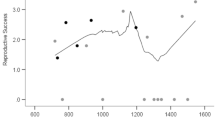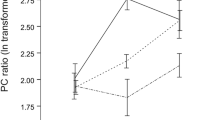Abstract
House mice release chemosignals in their urine that influence the timing of puberty and reproductive condition in conspecific females. These experiments tested the possibility that mice depositing urine containing chemosignals that affect puberty and reproduction do so differentially with respect to urine cues from conspecifics. Mice were tested in cages containing samples of urine or water on cotton in wire mesh capsules protruding from the cage floor. Their urine deposition patterns were recorded on squares of filter paper positioned below the cages. Males deposited more urine than females housed in groups, estrous females, diestrous females, or prepubertal females. All groups of mice deposited urine in a nonrandom fashion with regard to urine cues from conspecifics. Male mice deposited more urine near locations previously soiled by females than near water or other males. Grouped females deposited more urine near male urine cues and avoided depositing urine near urine from other group-housed females. Both estrous and diestrous female mice deposited more urine near males than near other urine cues or water, possibly to attract mates. Prepubertal females avoided depositing their urine near male urine and urinated more near urine from grouped females than near other urine types or water. Young females may be avoiding possible male mates until they have attained puberty. This avoidance behavior may enhance the long-term reproductive success of the females that otherwise might mature and mate at too young an age.
Similar content being viewed by others
References
Beauchamp, G., Gilbert, A., Yamazaki, K., andBoyse, E.A. 1986. Genetic basis for individual discriminations: the major histocompatability complex of the mouse, pp. 413–422,in D.M. Duvall, D. Muller-Schwarze, and R.M. Silverstein (eds.). Chemical Signals in Vertebrates IV. Plenum Press, New York.
Bronson, F.H. 1976. Urine marking in mice: Causes and effects, pp. 119–141,in R.L. Doty (ed.). Mammalian Olfaction, Reproductive Processes, and Behavior. Academic Press, New York.
Bronson, F.H. 1979. The reproductive ecology of the house mouse.Quart. Rev. Biol. 54:265–299.
Bruce, H.M. 1960. A block to pregnancy in the mouse caused by proximity of strange males.J. Reprod. Fertil. 1:96–103.
Colby, D.R., andVandenbergh, J.G. 1974. Regulatory effects of urinary pheromones on puberty in the mouse.Biol. Reprod. 11:268–276.
Cox, T.P. 1984. Ethological isolation between local populations of house mice (Mus musculus) based on olfaction.Anim. Behav. 32:1068–1077.
Desjardins, C., Maruniak, J.A., andBronson, F.H. 1973. Social rank in house mice: Differentiation revealed by ultraviolet visualization of urinary marking patterns.Science 182:939–941.
Drickamer, L.C. 1974. Sexual maturation in female mice: social inhibition.Dev. Psychobiol. 7:257–265.
Drickamer, L.C. 1977. Delay of sexual maturation in female house mice by exposure to grouped females or urine from grouped females.J. Reprod. Fertil. 51:77–81.
Drickamer, L.C. 1986a. Puberty-influencing chemosignals in mice: Ecological and evolutionary considerations, pp. 441–455,in D. Duvall, D. Muller-Schwarze, and R.M. Silverstein (eds.). Chemical Signals in Vertebrates IV. Plenum Press, New York.
Drickamer, L.C. 1986b. Effects of urine from females in oestrus on puberty in female mice.J. Reprod. Fertil. 77:613–622.
Drickamer, L.C. 1988. Long terms effects of accelerated or delayed sexual maturation on reproductive output in wild female house mice (Mus musculus). J. Reprod. Fertil. In press.
Drickamer, L.C., andHoover, J.E. 1979. Effects of urine from pregnant and lactating female house mice on sexual maturation of juvenile females.Dev. Psychobiol. 12:545–551.
Drickamer, L.C., andMurphy, R.X. 1978. Female mouse maturation: effects of excreted and bladder urine from juvenile and adult females.J. Reprod. Fertil. 55:297–301.
Egid, K., andLenington, S. 1985. Responses of male mice to odors of females: Effects ofT andH-2 locus genotype.Behav. Genet. 15:287–295.
Harrington, J.E. 1976. Recognition of territorial boundaries by olfactory cues in mice (Mus musculus L.).Z. Tierspychol. 41:295–306.
Hoover, J.E., andDrickamer, L.C. 1978. Effects of urine from pregnant and lactating female house mice on oestrous cycles of adult females.J. Reprod. Fertil. 55:297–301.
Hurst, J.L. 1987. The functions of urine marking in a free-living population of house mice,Mus domesticus Rutty.Anim. Behav. 35:1433–1442.
Jones, R.B., andNowell, N.W. 1974. The urinary aversive pheromone of mice: Species, strain and grouping effects.Anim. Behav. 22:187–191.
Kimura, T. 1971. Modification of the oestrous cycle in mice housed together with normal or ovariectomized females.Sci. Pap. Coll. Gen. Educ. Univ. Kyoto 21:161–166.
Kimura, T., andHagiwara, Y. 1985. Regulation of urine marking in male and female mice: Effects of sex steroids.Horm. Behav. 19:64–70.
Lenington, S. 1983. Social preferences for partners carrying “good genes” in wild house mice.Anim. Behav. 31:325–333.
Mackintosh, J.H. 1973. Factors affecting the recognition of territory boundaries by mice (Mus musculus).Anim. Behav. 21:464–470.
Marchlewska-Koj, A. 1983. Pregnancy blocking by pheromones, pp. 151–174,in J.G. Vandenbergh (ed.). Pheromones and Mammalian Reproduction. Academic Press, New York.
Maruniak, J.A., Owen, K., Bronson, F.H., andDesjardins, C. 1974. Urinary marking in male house mice: responses to novel environmental and social stimuli.Physiol. Behav. 12:1035–1039.
Maruniak, J.A., Owen, K., Bronson, F.H., andDesjardins, C. 1975. Urinary marking in female house mice: Effects of ovarian steroids, sex experience, and type of stimulus.Behav. Biol. 13:211–217.
Matthews, M.K. 1980. Urinary marking and tendency to investigate novelty inMus musculus.Behav. Neural Biol. 28:501–506.
McClintock, M.K. 1983. Pheromonal regulation of the ovarian cycle: Enhancement, suppression and synchrony, pp. 113–149,in J.G. Vandenbergh (ed.). Pheromones and Mammalian Reproduction. Academic Press, New York.
Parkes, A.S., andBruce, H.M. 1962. Pregnancy-block in female mice placed in boxes soiled by males.J. Reprod. Fertil. 4:303–308.
Powell, A.J., andWolff, P. 1982. Sex differences in mouse urination patterns.Anim. Behav. 30:1207–1211.
Reynolds, E. 1971. Urination as a social response in mice.Nature 234:481–483.
Vandenbergh, J.G. 1967. Effect of the presence of a male on the sexual maturation of female mice.Endocrinology 84:658–661.
Vandenbergh, J.G. 1969. Male odor accelerates female sexual maturation in mice.Endocrinology 84:658–660.
Vandenbergh, J.G. 1983. Pheromonal regulation of puberty, pp. 95–111,in J.G. Vandenbergh (ed.). Pheromones and Reproduction in Mammals. Academic Press, New York.
Vandenbergh, J.G., Drickamer, L.C., andColby, D.R. 1972. Social and dietary factors in the sexual maturation of female mice.J. Reprod. Fertil. 28:397–402.
Welch, J.F. 1953. Formation of urinating “posts” by house mice (Mus) held under restricted conditions.J. Mammal. 34:502–503.
Whitten, W.K. 1957. Effect of exteroceptive factors on the oestrous cycles of mice.Nature 180:1436.
Whitten, W.K. 1959. Occurrence of anoestrous in mice caged in groups.J. Endocrinol. 18:102–107.
Wolff, P., andPowell, A.J. 1979. Urination patterns and estrous cycling in mice.Behav. Neural Biol. 27:379–383.
Wolff, P., andPowell, A. J. 1984, Urine patterns in mice: An analysis of male/female counter-marking.Anim. Behav. 32:1185–1191.
Author information
Authors and Affiliations
Rights and permissions
About this article
Cite this article
Drickamer, L.C. Patterns of deposition of urine containing chemosignals that affect puberty and reproduction by wild stock male and female house mice (Mus domesticus). J Chem Ecol 15, 1407–1421 (1989). https://doi.org/10.1007/BF01012373
Received:
Accepted:
Issue Date:
DOI: https://doi.org/10.1007/BF01012373




